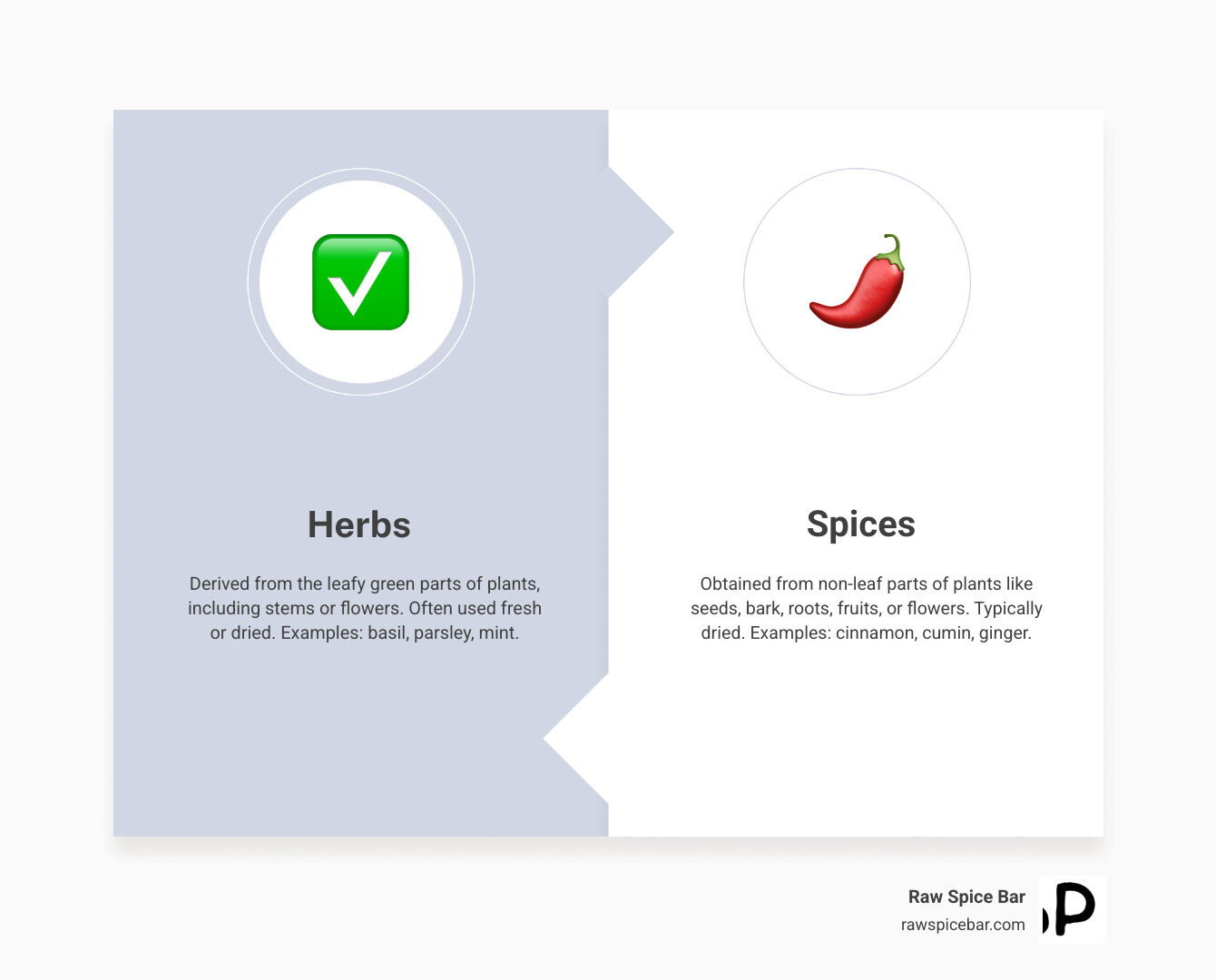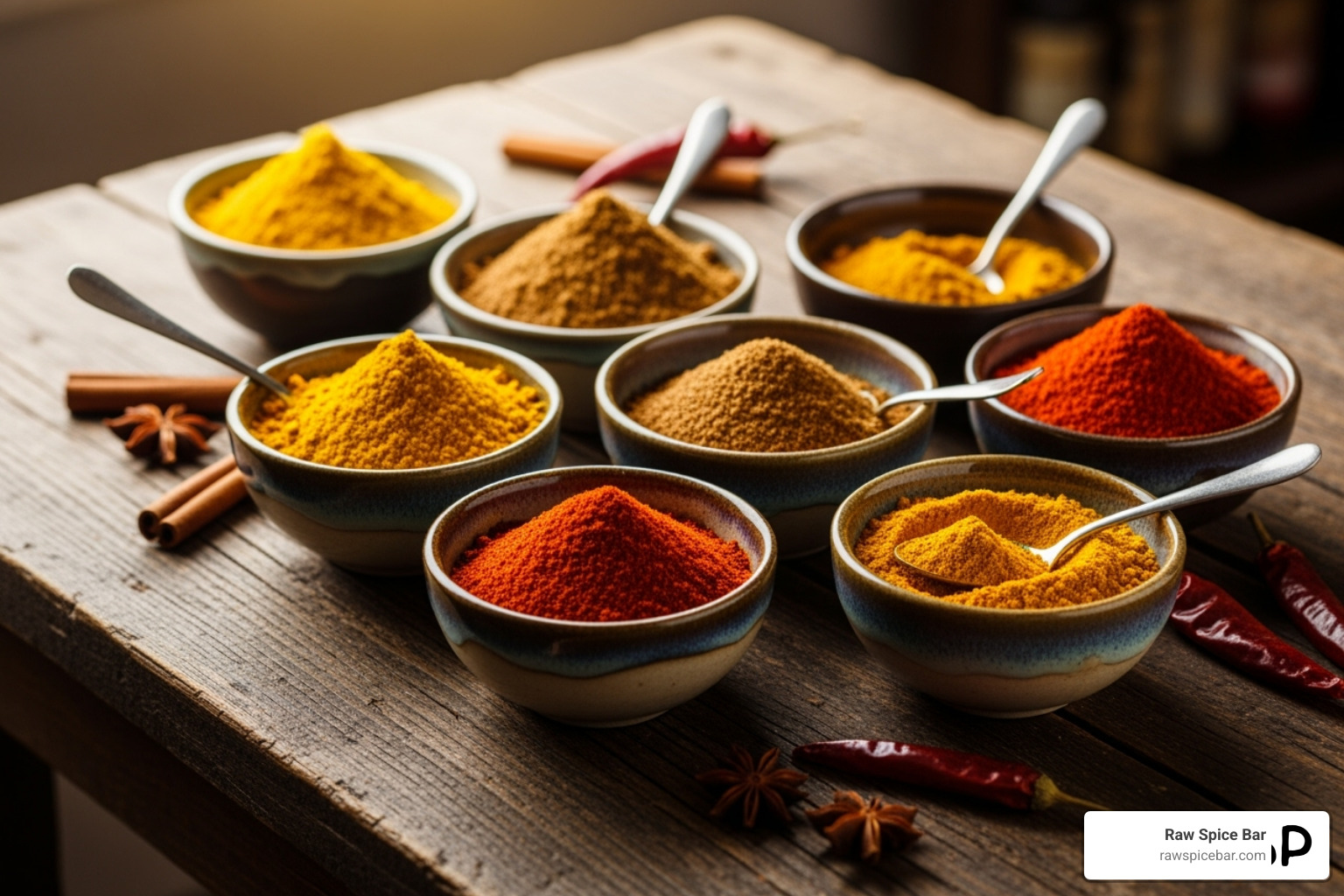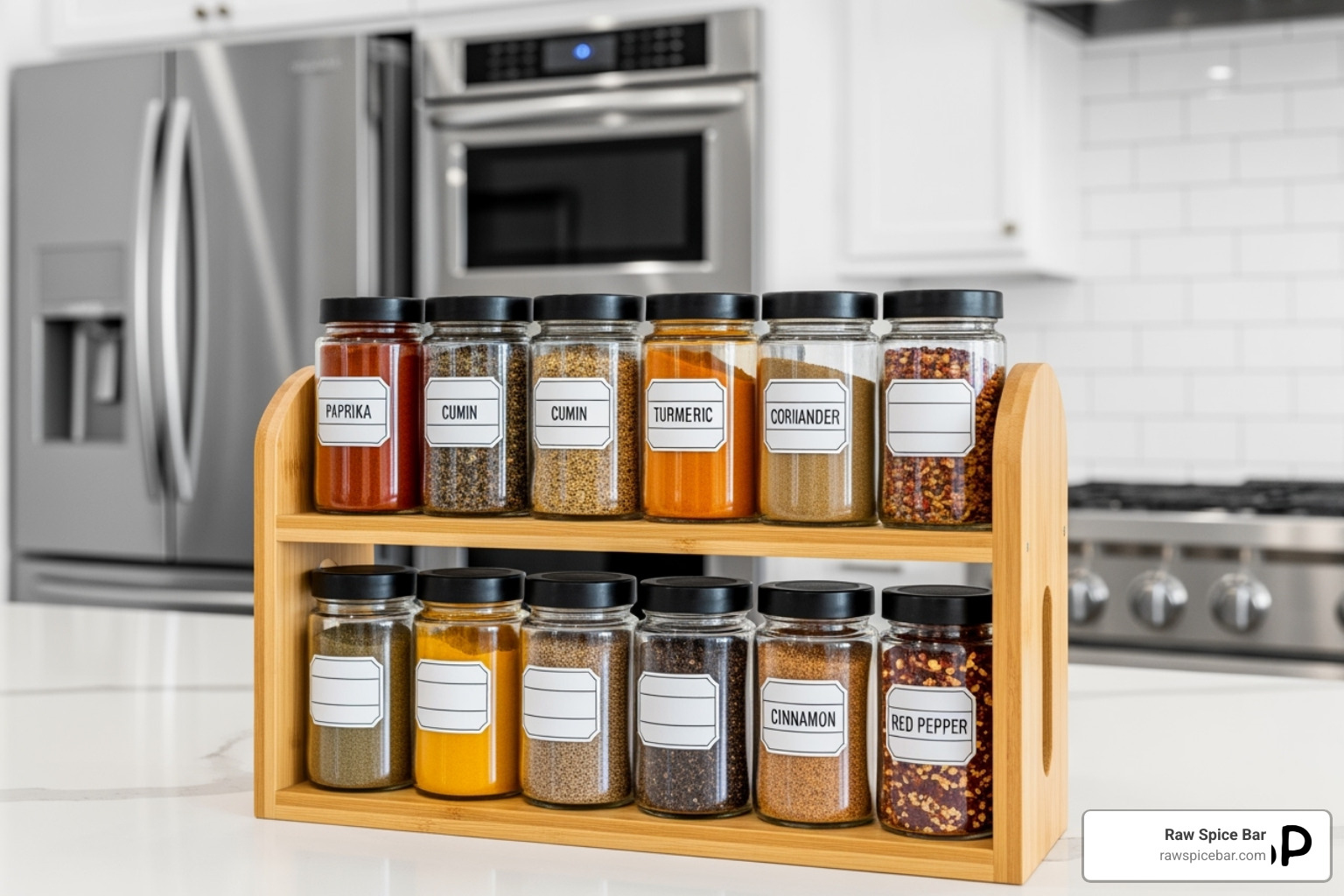Your Guide to the World of Flavor
A comprehensive list of herbs and spices opens up endless possibilities in your kitchen. Whether you're looking to add fresh brightness with basil or warm depth with cinnamon, understanding these flavor powerhouses transforms ordinary meals into extraordinary experiences.
The spice trade was once so valuable that black pepper served as currency. Today, these aromatic treasures are more accessible than ever, yet many home cooks stick to the same few spices on their rack.
From the Mediterranean's oregano to India's turmeric, every culture has developed its signature flavor profiles using local herbs and spices. Understanding these ingredients helps you recreate authentic dishes and develop your own unique cooking style.
I'm Joseph Rosenblatt, founder of a premium spice brand. I've spent years crafting global-inspired blends and believe the right ingredients from a comprehensive list of herbs and spices can transform any home cook into a flavor artist.

Quick look at list of herbs and spices:
- herbs for healing
- good salt substitute
What's the Difference Between an Herb and a Spice?
Ever wondered why basil is called an herb while cinnamon is a spice? The answer lies in which part of the plant we're using, and understanding this difference will help you build a better list of herbs and spices for your kitchen.
Herbs come from the leafy, green parts of plants. Most grow in temperate climates and can be used fresh or dried. Fresh herbs have bright, delicate flavors, while dried herbs offer more concentrated, earthy notes.
Spices come from everywhere else on the plant—the seeds, bark, roots, flowers, and fruits. They're usually dried and often hail from tropical regions. This is how we get the warmth of cinnamon from tree bark, the glow of turmeric from roots, and the bite of black pepper from dried berries.
Here's where the magic happens: leaves give us herbs like basil, flowers provide cloves, seeds deliver cumin, bark brings us cinnamon, and roots offer ginger. Even stems like lemongrass find their way into our spice collections.
The intensity difference is striking. Spices pack such a powerful punch that historically, black pepper was used as currency. The Spices: Exotic Flavors and Medicines resource dives deep into this fascinating history.
One game-changing tip: try toasting your whole spices before grinding them. The difference in aroma and flavor will amaze you. Check out our guide on toasting spices to open up this simple technique.
Herbs: The Leafy Flavor-Makers
Fresh herbs lift dishes with their vibrant, aromatic qualities. They work best when added toward the end of cooking or as fresh garnishes to preserve their delicate nature.
Basil brings sweet, peppery notes to Italian classics like pesto and Caprese salads.
Parsley offers a fresh, peppery bite that brightens soups, sauces, and garnishes.
Cilantro provides citrusy brightness essential for Mexican salsas and Indian curries. Its love-it-or-hate-it flavor is due to genetics.
Rosemary has pine-like, woody aromatics perfect for roasted lamb and stews. Use this robust herb sparingly.
Thyme provides earthy, minty notes, forming the backbone of French cooking and enhancing everything from poultry to roasted vegetables.
Oregano delivers the bold, pungent flavor that defines Mediterranean dishes, especially pizza.
Mint cools with its menthol notes, perfect for teas, desserts, and lamb dishes.
Sage has an earthy, piney character that lifts brown butter sauces and holiday stuffings.
These herbs often work together in regional blends like the classic French Herbes de Provence, which captures the essence of Mediterranean cooking.
Spices: The Aromatic Powerhouses
Spices bring warmth, depth, and often heat to dishes, working their magic throughout the cooking process.
Cinnamon, from tree bark, delivers sweet, woody warmth to desserts and savory dishes. Both cassia and Ceylon varieties are valuable additions to your list of herbs and spices.
Cumin provides earthy, warm notes that are foundational to Mexican, Middle Eastern, and Indian cuisines, essential for tacos and curries.
Turmeric paints dishes golden with its earthy, slightly bitter flavor and offers impressive health benefits.
Paprika adds gorgeous color and flavor, ranging from sweet and mild to hot and smoky. It's perfect for everything from deviled eggs to goulash.
Black pepper, the king of spices, adds a pungent, woody bite to nearly any dish. This everyday spice has an extraordinary history. Learn more about The Origins of Black Pepper.
Cloves are aromatic flower buds, perfect for mulled wine and holiday baking.
Nutmeg adds warm, nutty sweetness to pies and creamy sauces.
Ginger provides pungent, spicy heat with sweet undertones, ideal for stir-fries and baked goods.
These spices are cultural storytellers, carrying tales of ancient trade routes in every pinch.
The Ultimate List of Herbs and Spices
When you think about a list of herbs and spices, you're really thinking about a passport to the world's kitchens. Every region has developed its own signature flavors using local ingredients, creating incredible culinary diversity.

The spice trade literally shaped our world. Saffron, from the stigmas of Crocus sativus flowers, requires 75,000 blossoms for one pound, making it the most expensive spice on Earth. Its golden color and honeyed flavor have captivated cooks for millennia.
Today, we source ingredients from every corner of the globe—turmeric from India, cinnamon from Sri Lanka, and vanilla from Madagascar. This global network brings authentic flavors from Italy, Morocco, Mexico, and beyond to your kitchen. Explore this diversity with our Spice Odyssey: Exploring Global Kitchen Spices.
Common Herbs: A-Z list of herbs and spices for fresh flavor
Fresh herbs brighten, lift, and transform ordinary dishes into something memorable.
Basil: Sweet and peppery, it's the star of Italian pesto and Southeast Asian curries.
Bay Leaf: Adds subtle, earthy depth to soups and stews. Remove before serving.
Chives: Offers a mild, grassy onion flavor, perfect for eggs and potatoes.
Cilantro: Provides a bright, citrusy punch essential for Mexican salsas and Indian chutneys. Its divisive flavor is genetic.
Dill: Brings fresh, slightly anise notes that pair perfectly with fish and pickles.
Marjoram: A gentler, sweeter cousin of oregano, ideal for poultry dishes.
Mint: Cools and refreshes, working well in dishes from lamb to chocolate desserts.
Oregano: The pungent, earthy heart of Mediterranean cooking, essential for pizza.
Parsley: Its clean, peppery freshness lifts soups, sauces, and salads.
Rosemary: Piney, woody aromatics make it irresistible with roasted lamb and potatoes.
Sage: Earthy and peppery, it's the essence of autumn comfort food. Find alternatives in our guide: Exploring Savory Alternatives: A Comprehensive Guide to Sage Leaf Substitutes.
Tarragon: Features a distinctive anise flavor adored in French cooking, especially béarnaise sauce.
Thyme: Its earthy, woody character suits everything from stews to roasted vegetables.
Common Spices: A global list of herbs and spices for depth and warmth
Spices add layers of complexity that transform simple ingredients into extraordinary meals.
Allspice: Combines notes of cloves, cinnamon, and nutmeg. It's the secret to Jamaican jerk seasoning.
Black Pepper: The king of spices, it adds woody heat to everything. Learn the difference between varieties in our comparison: White Pepper vs. Black Pepper.
Cardamom: Adds sweet, floral complexity to Indian curries and Scandinavian pastries.
Cayenne Pepper: Delivers fiery heat to wake up any dish.
Cinnamon: Wraps dishes in warm, sweet comfort.
Cloves: Intensely aromatic; a little goes a long way.
Coriander Seed: Warm and citrusy, it pairs perfectly with cumin in Middle Eastern food.
Cumin: Its earthy flavor is foundational to Mexican, Indian, and Middle Eastern cooking.
Ginger: Brings pungent spice and subtle sweetness, and also soothes upset stomachs.
Mustard Seed: Ranges from mild yellow to fiery brown and black varieties.
Nutmeg: Adds warm, nutty sweetness to everything from eggnog to cream sauces.
Paprika: Paints dishes with beautiful red color while adding sweet, peppery flavor.
Saffron: The world's most precious spice, its delicate flavor and golden color make paella unforgettable. Explore What Does Saffron Taste Like? The Magical Allure.
Star Anise: Brings distinctive licorice notes to Chinese five-spice blends.
Turmeric: Rounds out our list with earthy bitterness and vibrant yellow color.
Unique Herbs and Spices to Find
Beyond the familiar lies a world of extraordinary flavors waiting to transform your cooking.
Asafoetida: This pungent resin transforms into savory, oniony flavor when cooked in oil, a staple in Indian vegetarian cooking.
Caraway: Brings warm, anise notes to European breads and sauerkraut.
Fenugreek: Toasted seeds smell like maple syrup and add complex bitterness to Indian curries.
Grains of Paradise: From West Africa, these offer peppery, citrusy heat, great as a black pepper substitute.
Sumac: Adds bright, lemony tartness and a beautiful red color to Middle Eastern dishes. Learn more in The Story Behind Sumac and Its Unique Flavor Profile.
Shiso: A Japanese leaf combining notes of mint, basil, and citrus.
Vadouvan: A French-style curry powder that's milder and sweeter than traditional blends.
Za'atar: An earthy, tangy, and nutty Middle Eastern blend of herbs, sumac, and sesame seeds.
These unique spices connect us to distant cultures. For more, explore Middle Eastern Spices and Their Uses.
A World of Flavor: Popular Spice Blends & Cuisines
There's something magical that happens when individual herbs and spices come together. While a single spice can transform a dish, it's the artful combination of multiple flavors that creates the soul of global cuisines. These time-tested blends are culinary shortcuts, instantly transporting your taste buds around the world.

When you smell curry powder, you think of India. A whiff of Italian seasoning brings visions of the Mediterranean. These blends are cultural ambassadors in your spice rack.
The beauty of spice blends lies in their ability to balance complex flavors. Master blenders spend years perfecting ratios, ensuring no single ingredient overpowers another. If you're feeling adventurous, you can learn How to Blend Your Own Spice Mixes at Home and craft your own list of herbs and spices combinations.
Essential Spice Blends for Your Pantry
Having a selection of spice blends transforms everyday cooking. These serve as your passport to international flavors, making it easy to create authentic-tasting dishes.
Chili Powder: The backbone of Tex-Mex cooking, this blend of chili peppers, cumin, oregano, and garlic powder is essential for chili con carne and tacos.
Curry Powder: A complex and varied blend, typically with turmeric, coriander, cumin, and ginger. Its versatility shines in stews, soups, and roasted vegetables. Explore its nuances in Decoding Curry Powder: Origins, Varieties, and Culinary Trips.
Garam Masala: Meaning "hot spice," this Indian blend is more warm than fiery. Featuring coriander, cumin, and cardamom, it's best added at the end of cooking to preserve its aroma. Find alternatives in our guide to the Best Garam Masala Substitute.
Chinese Five Spice: Balances the five flavors with star anise, cloves, cinnamon, Sichuan peppercorns, and fennel. It's stunning with pork and duck.
Herbes de Provence: This French blend of savory, rosemary, thyme, and oregano brings sophistication to grilled meats and roasted vegetables.
Italian Seasoning: A versatile blend of basil, oregano, rosemary, and thyme, perfect for pizza, pasta sauces, and marinades.
Ras el Hanout: "Head of the shop," this complex Moroccan blend can contain dozens of spices like cardamom, cinnamon, and turmeric. It's the soul of tagines.
Shichimi Togarashi: A Japanese seven-spice blend with red chili pepper, orange peel, and sesame seeds. Use it as a finishing condiment on noodles and grilled meats.
Signature Flavors of Global Cuisines
Every cuisine tells a story through its signature spice combinations, developed over centuries of culinary evolution.
Indian cuisine is built on turmeric, cumin, coriander, and garam masala for a warm, aromatic, and complex profile. These spices define its rich curries and biryanis. Learn more in our guide to Essential Spices in Indian Cooking.
Mexican cuisine relies on cumin, chili powder, oregano, and cilantro for an earthy, smoky, and vibrant flavor. These spices are key to tacos, moles, and fresh salsas.
Italian cooking celebrates basil, oregano, parsley, and garlic for an aromatic and savory profile. These herbs are the soul of pasta sauces, pizzas, and roasted vegetables.
Thai cuisine balances lemongrass, galangal, kaffir lime leaves, and chili for an aromatic, spicy, and sour flavor profile found in green curry and Tom Yum soup.
Moroccan cooking features cumin, turmeric, ginger, and ras el hanout for warm, sweet, and earthy flavors in memorable tagines. Try our Step-by-Step Moroccan Chicken Tagine recipe to start.
Understanding these signature combinations from our comprehensive list of herbs and spices opens up a world of culinary possibilities.
From Pantry to Plate: Storage, Health, and Cooking Tips
Now that we've explored the incredible list of herbs and spices, let's talk about how to get the most out of them. Proper storage ensures their potency, understanding their health benefits adds another layer of appreciation, and smart cooking techniques open up their full flavor potential.

A well-organized spice rack is your secret weapon for keeping flavors vibrant and accessible. When your spices are properly stored, you're more likely to try something new. To dive deeper, check out our guide on the Best Ways to Store Spices for Freshness.
How to Store Herbs and Spices
Protect your spices from their four enemies: light, heat, moisture, and air. Proper storage ensures your list of herbs and spices stays vibrant for years.
Airtight containers are your first line of defense. Glass jars with tight-fitting lids are ideal as they don't absorb odors and let you see what you have.
Location matters. Store spices in a cool, dark place like a pantry, not above your stove where heat and steam will degrade them.
When stored properly, whole spices last 2-4 years, ground spices 2-3 years, and dried herbs 6 months to 3 years. Spices don't spoil, but they do lose potency over time. For the complete story, read Do Spices Expire? When to Replace Your Spices. And if you've never experienced the difference, find out Why Freshly Ground Spices Make a Difference.
The Health Benefits of Herbs and Spices
Your list of herbs and spices is packed with antioxidants and anti-inflammatory properties, adding a dose of wellness to every meal.
Half a teaspoon of ground cinnamon contains as many antioxidants as half a cup of blueberries! And half a teaspoon of dried oregano packs the antioxidant punch of three cups of raw spinach. These compounds fight oxidative damage in your body.
Turmeric's active compound, curcumin, is a powerful anti-inflammatory. Pair it with black pepper to boost absorption.
Ginger has a long history of soothing stomachs and fighting inflammation, nausea, and digestive discomfort.
Cinnamon helps control blood sugar levels and is packed with heart-healthy antioxidants.
Garlic's allicin content boosts the immune system and supports heart health by helping lower blood pressure and cholesterol.
Cayenne's capsaicin can boost metabolism, reduce appetite, and fight inflammation.
For more insights into how your spice rack doubles as a medicine cabinet, explore 10 Delicious Herbs and Spices with Powerful Health Benefits and Health Benefits of Cinnamon, Black Pepper, and More.
Pro Cooking Tips
Knowing your list of herbs and spices is just the beginning—the real magic is learning to coax out their full potential.
Toasting spices in a dry pan for a minute or two is a simple game-changer. The heat releases volatile oils, creating deeper, nuttier, and more complex flavors.
Blooming spices in oil at the start of cooking infuses the entire dish with flavor. This is a key technique in Indian and Middle Eastern cooking. Master it with our guide on How to Bloom Spices in Oil.
Layering flavors separates good cooks from great ones. Add robust spices early and delicate fresh herbs at the very end to create depth and complexity.
Fresh vs. dried herbs: Add fresh herbs at the end of cooking; dried herbs can withstand longer cooking. Use about one-third the amount of dried herbs when substituting for fresh.
Most importantly, don't be afraid to experiment. Start with small amounts, taste as you go, and adjust to your preference. For inspiration, check out From Bland to Grand: Mastering the Art of Cooking With Spices.
Conclusion: Start Your Flavor Journey
We've explored a comprehensive list of herbs and spices, from everyday heroes like basil and black pepper to exotic treasures like sumac and grains of paradise.
We've learned the difference between herbs and spices, the importance of proper storage, and the incredible health benefits they offer. Techniques like toasting spices to release their oils and blooming them in oil for deeper flavor are your keys to changing simple ingredients into extraordinary meals.
Your spice rack is a flavor laboratory. Every jar holds the potential for culinary magic, so accept experimentation by starting small, tasting often, and trusting your instincts.
At Raw Spice Bar, we've made it our mission to bring you freshly packed, globally inspired spice blends that make exploring new flavors effortless. We source our ingredients from spice-growing regions around the world, ensuring you get the highest quality and most vibrant flavors for your culinary trips.
The world of flavor is waiting for you. Every cuisine tells a story through its signature spices, and now you have the knowledge to tell those stories in your own kitchen. Whether you're building your first spice collection or seeking your next exotic find, each herb and spice is an invitation to explore.
Ready to find your next favorite flavor? Find New Cuisines with Globally-Inspired Spices and let your taste buds guide you on this incredible journey. Happy cooking!




